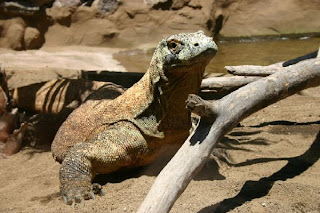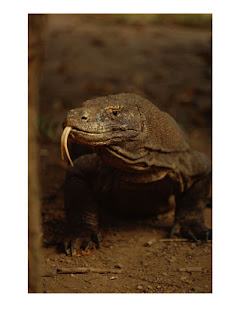 Varanidae: Varanus Komodoensis
Varanidae: Varanus KomodoensisThe Komodo Dragon lizard, discovered by the West in 1910, is the world's largest lizard and can grow up to three metres (almost ten feet) in length. Average lifespan is around twenty years. They live on a small number of Indonesian islands, including the eponymous Komodo Island itself. Their preferred habitat is dry, hot places such as open grassland. They are currently classified as a vulnerable species however they could become endangered.
 A komodo dragon
A komodo dragon
Komodos are part of the awesome monitor lizard family. They can see up to 300 metres and their eyes are better adapted to seeing movement than stationary objects. Komodo dragons were initially thought to be completely deaf, however more recent research has shown that they can hear, albeit in a restricted frequency range.
The Komodo's main hunting sense is that of smell. The lizard samples the air with its tongue then returns the two tongue tips to the mouth where the air is "analysed". A Komodo dragon can sense the smell of carrion up to four kilometres (two and a half miles) away.
Given their size, Komodo dragons are not built for a long chase - however they can sprint at up to 20 kilometres per hour (12 miles per hour) for short periods of time. Their preferred hunting strategy to get food is thus to sit quietly in one spot waiting for something big and tasty to come near.
In fact if the Komodo lizard's prey escapes after it is bitten then it could still become dragon food; the Komodo's bite is toxic to other creatures.
Big komodo dragons are quite capable of killing and eating a human being and there are many accounts of this occuring.
Note: The Komodo Dragon is sometimes referred to as the Komoto or even Comodo Dragon
 A komodo dragon
A komodo dragonKomodos are part of the awesome monitor lizard family. They can see up to 300 metres and their eyes are better adapted to seeing movement than stationary objects. Komodo dragons were initially thought to be completely deaf, however more recent research has shown that they can hear, albeit in a restricted frequency range.
The Komodo's main hunting sense is that of smell. The lizard samples the air with its tongue then returns the two tongue tips to the mouth where the air is "analysed". A Komodo dragon can sense the smell of carrion up to four kilometres (two and a half miles) away.
Given their size, Komodo dragons are not built for a long chase - however they can sprint at up to 20 kilometres per hour (12 miles per hour) for short periods of time. Their preferred hunting strategy to get food is thus to sit quietly in one spot waiting for something big and tasty to come near.
In fact if the Komodo lizard's prey escapes after it is bitten then it could still become dragon food; the Komodo's bite is toxic to other creatures.
Big komodo dragons are quite capable of killing and eating a human being and there are many accounts of this occuring.
Note: The Komodo Dragon is sometimes referred to as the Komoto or even Comodo Dragon

